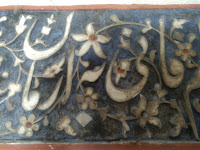 The first time I heard about
Sunder Nursery was when I was flipping through the pages of Pradip Krishen’s
fabulous compilation on the trees of Delhi. Many of the trees featured in the
book were the sole standing specimens found here. I nursed a wish for many
years to visit the place but could not convince my History loving husband or
son to take me there. In recent times, I read about the conservation and restoration
of the monuments and gardens within Nursery area by the Aga Khan Trust for
Culture and the accolades that it was winning for creating a beautiful public space
in a city.
The first time I heard about
Sunder Nursery was when I was flipping through the pages of Pradip Krishen’s
fabulous compilation on the trees of Delhi. Many of the trees featured in the
book were the sole standing specimens found here. I nursed a wish for many
years to visit the place but could not convince my History loving husband or
son to take me there. In recent times, I read about the conservation and restoration
of the monuments and gardens within Nursery area by the Aga Khan Trust for
Culture and the accolades that it was winning for creating a beautiful public space
in a city. When my college friends asked me
what I would want to do on the Sunday that we chose to spend together, I
immediately mentioned Sunder Nursery, which we all agreed that it would be a
good idea. So the three of us took off on a Sunday morning with guide Amir leading
us for a tour of the complex. Fortunately, the air was clear and the sky was
blue on the day adding to the beauty and freshness of the place.
When my college friends asked me
what I would want to do on the Sunday that we chose to spend together, I
immediately mentioned Sunder Nursery, which we all agreed that it would be a
good idea. So the three of us took off on a Sunday morning with guide Amir leading
us for a tour of the complex. Fortunately, the air was clear and the sky was
blue on the day adding to the beauty and freshness of the place.Sunder Nursery or Azim Bagh as it was known in the past, is situated close to Humayun’s Tomb in the Nizamuddin area, over 90 acres, and is home to six monuments on the UNESCO’s World Heritage List. The Grand Trunk Road passed through the Nursery, providing rest and respite to travelers and traders of yore. The monuments built in the style of Mughal architecture feature domes, decorative ceilings, majestic arched pavilions and exquisite wall designs incorporating verses from the Koran interspersed with floral patterns. Painstakingly restored, the monuments add to the beauty and ambience.

The landscaped gardens are home
to over 200 species of trees, many rare and exotic, a variety of birds and
butterflies and several varieties of roses. Well-designed and manicured gardens
sit easily with wilderness that is reflective of Delhi’s original ecosystem. Fountains,
lakes and gently flowing streams add to the beauty and liveliness of the
gardens. A flower laden lotus pond (apparently the only surviving one from the
Mughal era) is a sight to behold. The British used Sunder Nursery in the nineteenth century to grow and propagate trees for their new capital city, bringing in
exotic varieties from across the world.
 The Nursery hosts a Sunday market
of local, traditional and organic produce with a variety of food items for a
leisurely and healthy brunch. There is
an amphitheatre beside the lotus pond that can host shows and performances.
Spaces for children to play, for activities like yoga and walking and for
family and school picnics dot this green lung as Sunder Nursery truly stands
out as a unique public space in a mega city that brings together, history,
nature and heritage providing education, entertainment and relaxation.
The Nursery hosts a Sunday market
of local, traditional and organic produce with a variety of food items for a
leisurely and healthy brunch. There is
an amphitheatre beside the lotus pond that can host shows and performances.
Spaces for children to play, for activities like yoga and walking and for
family and school picnics dot this green lung as Sunder Nursery truly stands
out as a unique public space in a mega city that brings together, history,
nature and heritage providing education, entertainment and relaxation.
If I could visit again, I would certainly.
For more pictures, please click https://photos.google.com/SunderNursery
For more pictures, please click https://photos.google.com/SunderNursery


Very informative and well written blog. Eager to visit the place.
ReplyDeleteBeautifully described and lucky enough to have spent such beautiful moments with friends ! I’ll visit this place when I go next.Thanks Gappy.
ReplyDelete